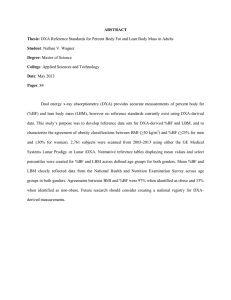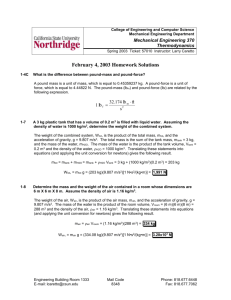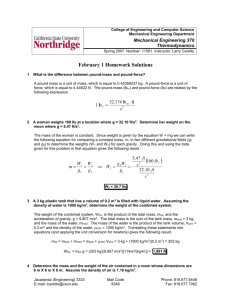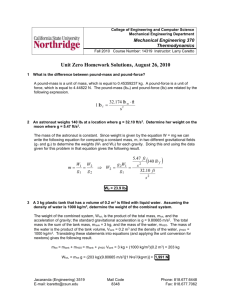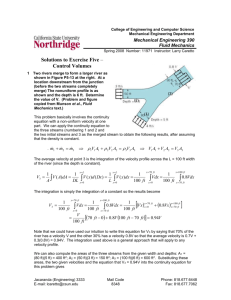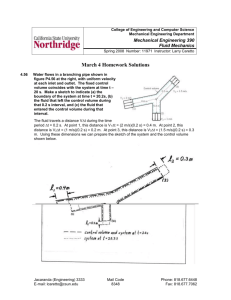January 31 solutions
advertisement
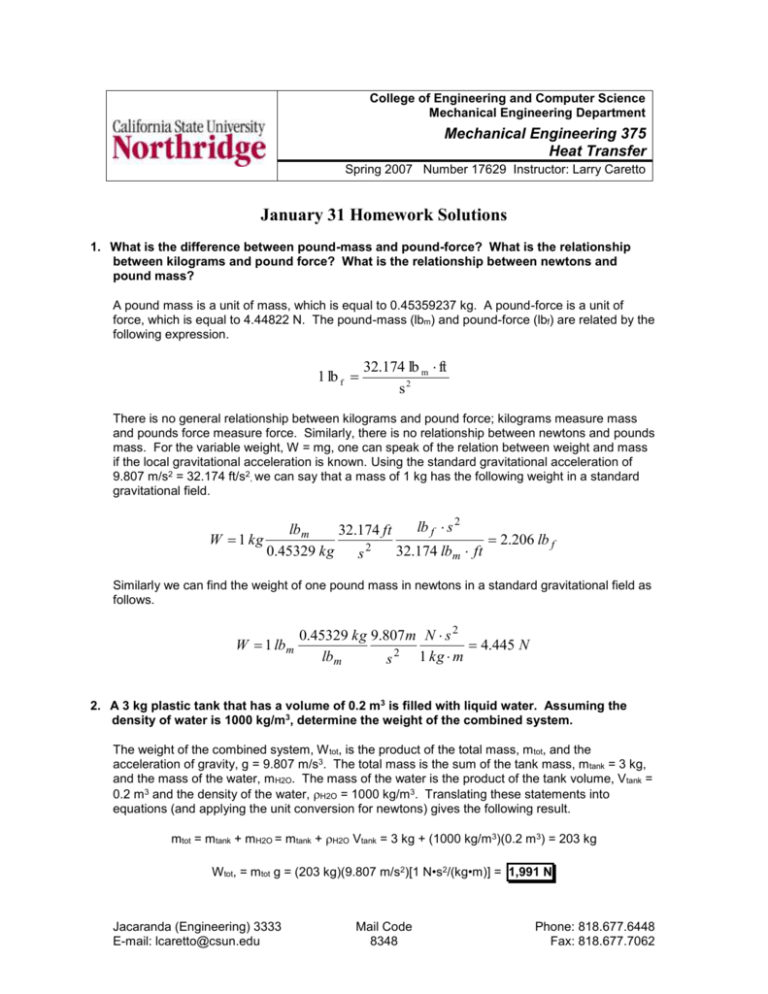
College of Engineering and Computer Science Mechanical Engineering Department Mechanical Engineering 375 Heat Transfer Spring 2007 Number 17629 Instructor: Larry Caretto January 31 Homework Solutions 1. What is the difference between pound-mass and pound-force? What is the relationship between kilograms and pound force? What is the relationship between newtons and pound mass? A pound mass is a unit of mass, which is equal to 0.45359237 kg. A pound-force is a unit of force, which is equal to 4.44822 N. The pound-mass (lbm) and pound-force (lbf) are related by the following expression. 1 lb f 32.174 lb m ft s2 There is no general relationship between kilograms and pound force; kilograms measure mass and pounds force measure force. Similarly, there is no relationship between newtons and pounds mass. For the variable weight, W = mg, one can speak of the relation between weight and mass if the local gravitational acceleration is known. Using the standard gravitational acceleration of 9.807 m/s2 = 32.174 ft/s2, we can say that a mass of 1 kg has the following weight in a standard gravitational field. lb f s 2 lbm 32.174 ft W 1 kg 2.206 lb f 0.45329 kg 32.174 lbm ft s2 Similarly we can find the weight of one pound mass in newtons in a standard gravitational field as follows. W 1 lbm 0.45329 kg 9.807 m N s 2 4.445 N lbm s 2 1 kg m 2. A 3 kg plastic tank that has a volume of 0.2 m3 is filled with liquid water. Assuming the density of water is 1000 kg/m3, determine the weight of the combined system. The weight of the combined system, W tot, is the product of the total mass, m tot, and the acceleration of gravity, g = 9.807 m/s3. The total mass is the sum of the tank mass, m tank = 3 kg, and the mass of the water, m H2O. The mass of the water is the product of the tank volume, Vtank = 0.2 m3 and the density of the water, H2O = 1000 kg/m3. Translating these statements into equations (and applying the unit conversion for newtons) gives the following result. mtot = mtank + mH2O = mtank + H2O Vtank = 3 kg + (1000 kg/m3)(0.2 m3) = 203 kg W tot, = mtot g = (203 kg)(9.807 m/s2)[1 N•s2/(kg•m)] = 1,991 N Jacaranda (Engineering) 3333 E-mail: lcaretto@csun.edu Mail Code 8348 Phone: 818.677.6448 Fax: 818.677.7062 January 31 homework solutions ME370, L. S. Caretto, Spring 2006 Page 2 3. Determine the mass and the weight of the air contained in a room whose dimensions are 6 m X 6 m X 8 m. Assume the density of air is 1.16 kg/m3. The weight of the air, W air, is the product of the air mass, m air, and the acceleration of gravity, g = 9.807 m/s3. The mass of the air is the product of the room volume, Vroom = (6 m)(6 m)(8 m) = 288 m3 and the density of the air, air = 1.16 kg/m3. Translating these statements into equations (and applying the unit conversion for newtons) gives the following result. mair = air Vroom = (1.16 kg/m3)(288 m3) = 334 kg W air, = mair g = (334.08 kg)(9.807 m/s2)[1 N•s2/(kg•m)] = 3.28x103 N 4 A 150 lbm astronaut took a bathroom scale (a spring scale) and a beam scale (compares masses) to the moon where the local gravity is g = 5.48 ft/s2. Which scale will measure the astronaut’s weight? Determine the readings (a) on the spring scale and (b) on the beam scale. The beam balance measures mass by comparing the masses in each side of the balance; the spring scale measures the force applied to the spring, which is the astronaut’s weight. (a) The response of the spring scale is proportional to the force applied to the spring by the weight placed on the scale. In this case, we have weight of the astronaut, W a, which is the product of the astronaut’s mass, m a = 150 lbm, and the local acceleration of gravity, g =5.48 m/s2. Thus, the spring balance will measure the following weight, in pounds force, using the appropriate conversion factor. lb f s 2 5.48 ft Wa m a g (150 lb m ) = 25.5 lbf s 2 32.174 lb m ft (b) Beam balances do not measure weight. Instead, they compare the unknown mass in one side of the balance with known masse in the other side. When the masses on both sides are the same, regardless of the local gravitational field, the beam is in balance. The unknown mass must therefore be equal to the sum of the known masses placed on the other side. Thus the beam scale would tell the astronaut that his or her mass was 150 lbm, but it would not measure the astronaut’s weight.
